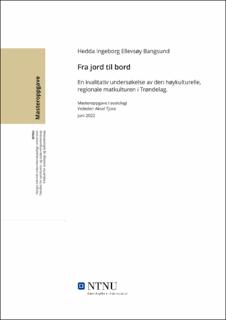| dc.contributor.advisor | Tjora, Aksel | |
| dc.contributor.author | Bangsund, Hedda Ingeborg Ellevsøy | |
| dc.date.accessioned | 2022-07-27T17:19:57Z | |
| dc.date.available | 2022-07-27T17:19:57Z | |
| dc.date.issued | 2022 | |
| dc.identifier | no.ntnu:inspera:104661571:22119087 | |
| dc.identifier.uri | https://hdl.handle.net/11250/3008939 | |
| dc.description.abstract | I denne masteroppgaven, er Trøndelags høykulturelle, regionale matkultur undersøkt. Nærmere bestemt er det det gastronomiske segmentet i matkulturen som har vært gjenstand for utforskning. Gjennom en fenomenologisk og sosialkonstruktivistisk tilnærming, har totalt 7 informanter – herunder råvareprodusenter, restauratører/kokker og aktører fra det offentlige – blitt intervjuet om regionens matkultur. Oppgaven tar videre sikte på å besvare tre forskningsspørsmål, som spør om hvilke faktorer som bidrar til å skape en trøndersk matregion i gastronomisegmentet, hvilke kvaliteter som verdsettes, og hvordan man kan forstå matkulturen som en sosial institusjon.
Det teoretiske rammeverket for oppgaven består av bidrag fra Goffman (1992), Bourdieu (1995; 2005; 2020), Veblen (2009) og Berger og Luckmann (2000), samt tidligere forskning fra feltet. Analysen er utformet i tråd med verdikjedens tre ledd – produksjon, distribusjon og konsum. Under hver av disse analysetemaene diskuteres ulike faktorer for hvordan matregionen er, og blir formet. Historiefortellinger peker seg ut som en av de mest fundamentale faktorene i formingen av en trøndersk matregion. Dette er historiefortellinger om de lokale råvarene, produsentene som står bak, om regionen og om håndverk og tradisjoner.
Arbeidet er gjort i tråd med den stegvis-deduktive induktive metode (Tjora, 2017; 2018). Her har målet vært, gjennom å kombinere teori og tidligere forskning med funn fra studien, å danne et konsept som kan generaliseres til å gjelde andre sammenhenger. I denne studien har begrepet ‘matkulturell fasade’ blitt utviklet. Begrepet fungerer som en forståelse av steder som har opparbeidet seg en fasade basert sin særegne matkultur. | |
| dc.description.abstract | In this master's thesis, Trøndelag's high-cultural, regional food culture is studied. More specifically, it is the gastronomy field of the food culture that has been the subject of exploration. Through a phenomenological and social constructivist approach, a total of 7 informants - including local farmers, restaurateurs/chefs, and participants from the public sector - have been interviewed about the region’s food culture. The thesis presents three research questions to uncover which factors contribute to creating a “trøndersk” food region in the gastronomy segment; which qualities are valued; and how the food culture is understood as a social institution.
The theoretical framework for the thesis consists of contributions from Goffman (1992), Bourdieu (1995; 2005; 2020), Veblen (2009), and Berger and Luckmann (2000), as well as previous research in the field. The analysis is designed in line with the food chain's three steps - production, distribution, and consumption. During each of these analysis topics, different factors for how the food region is shaped are discussed. Storytelling stands out as one of the most fundamental factors in the formation of the Trøndelag food region. These are stories about the local produce, the producers, about the region, and its traditions.
The work is done in line with the stepwise-deductive induction method (Tjora, 2017; 2018). The goal has been to combine theory and previous research with findings from the study, to form a concept that can be generalized to other contexts. In this study, the concept 'food culture façade' has been developed. The term serves as an understanding of places that have built up a façade based on their distinctive food culture. | |
| dc.language | nob | |
| dc.publisher | NTNU | |
| dc.title | Fra jord til bord | |
| dc.type | Master thesis | |
